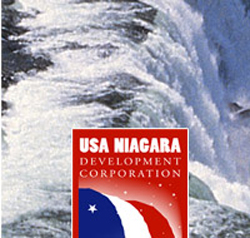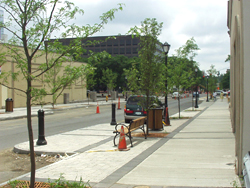State Needs to Deliver on Development
By Johnny Destino
 |
 |
| Third Street cut-outs, a signature USA Niagara failure |
Last week, Niagara Falls City lawmakers aimed to prevent what was called a ‘disaster’ for city workers and taxpayers, by voting to override Mayor Paul Dyster’s veto to restore $3.1 million in funding to renew the agreement with USA Niagara Development Corporation expiring December 31, 2012.
As was reported last week by the Niagara Falls Reporter, the funds that will not go to USA Niagara will be used this year to offset the need for property tax increases and employee layoffs as part of a proposed budget that contained a $28.1 million local tax levy.
USA Niagara, created by Governor George Pataki in 2001 as a subsidiary of the Empire State Development Corporation, has been the primary agency in charge of supporting and promoting economic development in Niagara Falls. The agency is supposed to leverage public money it receives to secure private investment in the city and encourage growth in the tourism market. Pataki promised at the time that it would do for Niagara Falls what state economic development did for New York City’s Times Square.
Structural problems in the way USA Niagara is funded, however, means the agency has received over $30 million in payments from the city, with very little additional funding coming from the state, and almost no spin-off investment without heavy public subsidies.
Since the city stopped receiving its share of casino money in 2009, it has resorted to paying USA Niagara entirely out of its state aid (Aid and Incentives for Municipalities or “AIM” funds). In budget year 2011-12, the city received $17,794,424 in AIM funding. State aid is provided to all of New York’s cities, towns and villages and with the intent to redistribute state tax revenues to municipalities that no longer have the tax base to generate sufficient revenues to cover operations.
AIM funds are unrestricted aid from the state that is supposed to alleviate the burden on local taxpayers. After three successive years without casino revenues, it came down to this: the Mayor and the City Council were forced to decide whether to increase property taxes to continue funding USA Niagara. The Council prevailed and cut off funding for 2013.
Niagara Falls now finds itself in the worst situation imaginable: It can no longer support funding economic development from local tax revenues; aid from the state is insufficient to continue funding economic development; and the revenue from casino gaming intended to offset the loss of fifty acres of prime real estate in downtown Niagara Falls may never be recouped. For the last three years, the city has been financing USA Niagara with its own money, without a guarantee that the casino cash is coming.
Mayor Dyster has raised concerns that eliminating funding to USA Niagara next year might result in the reduction of future funding from New York State. AIM funding, however, does not appear to be program specific and, given the level of fiscal distress the city is in, it does not appear likely that the city would see a reduction. According to a letter obtained by the Niagara Falls Reporter Niagara Falls Reporter from the Office of the State Comptroller to Councilmember Choolokian, there are a number of factors the Legislature takes into account when they determine AIM funding levels, but the funding agreement between the city and USA Niagara was a local matter.
According to the Comptroller’s Office, “AIM funding for each fiscal year is determined by the Governor and Legislature as a part of the budget-making process, and can be increased or decreased in response to such factors as the performance of the economy, revenue collections, and the existence of competing priorities.” The funding for fiscal year 2012-13 remains unchanged for all of New York State.
With operating losses and salaries exceeding $1 million annually, the overall effectiveness of USA Niagara has also been called into question by a majority of the City Council. Sam Fruscione, Glenn Choolokian and Robert Anderson are opposed to continuing to pay $3.1 million to fund what was supposed to be a state funded agency. Councilwoman Kristen Grandinetti, who agreed to cutting the agency’s funding in 2013 to deal with this year’s shortfall, believes the agency has been a tremendous asset to the city and hopes to resume negotiations for another agreement with USA Niagara as soon as next year.
Whether or not the city will be better off next year depends largely on the outcome of arbitration between New York State and the Seneca’s over whether the state violated the gaming compact’s exclusivity clause. State Comptroller Thomas P. DiNapoli recently issued a bleak report concerning two cities affected by the ongoing dispute. DiNapoli stated that “Niagara Falls and Salamanca face more severe stresses than most other cities in the state, and the loss of casino revenue has exacerbated their problems.” He continued that “[c]ity officials have been forced to make drastic budget cuts, spend down reserves and seek emergency aid from the state. Unfortunately, the systemic fiscal problems that have plagued these communities cannot be properly addressed until casino gaming issues are resolved.”
The emergency aid DiNapoli referenced was a proposal by Governor Cuomo to allow the city to “spin-up” its annual payments from the Niagara Power Project relicensing agreement. The spin-up payment from NYPA, which would have meant $13.4 million for the city this year to cover the budget shortfall, represented the present-day value of the forty-four years left on the original deal paying the city $850,000 per year. But, without any guarantees that the city would be made whole by the state if the Senecas’ win the arbitration hearing, the Niagara Falls City Council wasn’t willing to forego those future licensing payments in exchange for the immediate cash infusion, and instead decided to cut USA Niagara’s funding to cover the shortfall.
Even with the arbitration panel expected to rule on the casino issue at some point in 2013, USA Niagara’s funding may be in doubt even if the city receives its $60 plus million plus in slot revenues. Resolving the divide between the administration and the council majority over the agency’s effectiveness will more than likely prove to be the determining factor of whether or not a new agreement between Niagara Falls and USA Niagara can be reached.
The real deciding factor, of course, should be avoiding the perverse situation of having the city raise local taxes to pay for economic development. It’s time for the state to live up to its promises and deliver Niagara Falls a Times Square of its own.
More than ten years ago, it was promised that USA Niagara would transform downtown Niagara Falls into another Times Square. We leave it up to the readers to judge whether that promise was kept. It was supposed to be funded by the state, but it wound up becoming – as was surmised by the Reporter – a burden on local taxpayers since the city – not the state – was funding it out of their state aid money.
In the end, like so many other government development schemes, they wind up having the exact opposite effect than what the state originally intended. Instead of spurring development to create a greater tax base and overall reduction in taxes, USA Niagara, with its bloated bureaucracy and almost zero tax-paying developments, became the main reason the city needed to raise taxes. If USA Niagara were to fold up and go, they would not be missed by anyone other than those collecting patronage checks from its existence. It’s certainly time to get them off the backs of the overburdened taxpayers.